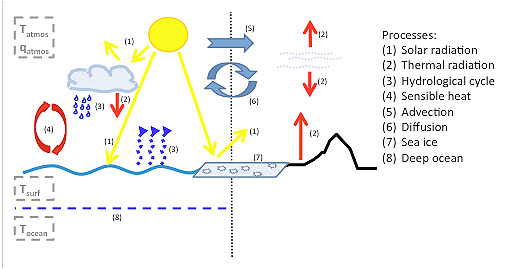
The Monash simple climate model (MSCM) is based on the spatially resolving global energy balance model (GREB) presented by Dommenget and Floeter [2011] in the journal Climate Dynamics. A more recent publication by Dommenget et al. [2019] describes the experiments possible with the model in greater detail.
The model simulates most of the important physical processes of the climate system in a highly simplified way, so that climate simulations can be performed with it quite quickly even on normal PCs. The global climate is simulated on a grid of 96 x 48 grid points for three vertical layers: The surface of land and sea, the atmosphere, and the deep ocean. Despite the strong simplifications, realistic climate changes caused by external forcings, such as the increase of the CO2 concentration, can be simulated.
The MSCM web interface, provided here at DKRZ with a German user interface, allows to study more than 1000 different precomputed model experiments in an interactive way. By turning on or off different elements and processes, individual interactions can be studied and their interaction in the climate system can be better understood. For example, the response of the climate system to a doubling of CO2 can be studied and it can be learned how the interactions between different physical processes change the climate. One can play through many different scenarios, learn from tutorials, and solve some fun and educational puzzles about interactions in climate dynamics.
To the german version of the Model (hosted at DKRZ):

